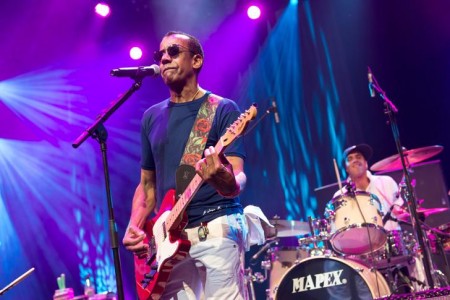We’ve been on a Brazilian music kick lately here at Afropop. Last week we sponsored the debut American screening of a great new documentary on Tropicália. And the week before we listed our favorite early Gilberto Gil classics as we presented a breathtaking live show that he played in New York. Now we’re featuring another fantastic Brazilian musician, a collaborator of Gil’s, who is also associated with the Tropicália movement: Jorge Benjor. Benjor will be performing this Sunday at the B.B. King Blues Club & Grill in New York.
In anticipation of that show, here is a short introduction to the life and work of Benjor. This isn’t the first time we’ve explored his career. Check out our Hip Deep program “The Tropical Soul of Jorge Benjor” if you want to delve deep into Benjor’s oeuvre.
Born in Rio de Janeiro in 1940 as Jorge Menezes, Jorge grew up listening to the “king of baião” Luiz Gonzaga and the samba singer Ataulfo Alves. As a teenager he became enraptured with the bossa nova guitarist João Gilberto. Though indebted to these earlier innovators, from the beginning of his career, Benjor left a unique imprint upon the Brazilian music scene. At first his stylistic idiosyncrasy stemmed from technical limitation-- unable to emulate the virtuosic playing of his hero Gilberto, Benjor instead played his guitar as if it were a bass. However, over time it became clear that there was far more to Benjor than a creative but imperfect bossa nova player.
His first big hit was “Mas, Que Nada,” which he released in 1963. In the song Benjor sings, “Esse samba/Que é misto de maracatu” (“This samba/Which is mixed with maracatu”). While other musicians stuck to one genre, Benjor mixed everything together, whether it was bossa nova, samba, baião or maracatu. What sticks out most about the song is Benjor’s singing-- his voice contains great warmth and feeling, and he has the range to jump scales and octaves, ending in an impressive high-pitch scat performance. Little wonder that Ella Fitzgerald later covered the song.
Benjor was already well established as a musician by the time that Gilberto Gil and Caetano Veloso broke onto the scene as leaders of the Tropicália movement. Benjor was not as politically minded as Gil or Veloso, but he shared a similar musical sensibility-- combining influence from the music of Brazil’s tropical Northeast with the psychedelic rock of England and the US. He later collaborated with Gil on the outstanding Ogum Xango record in 1975.Never content to stay within one genre or movement, Benjor next turned to Afro-Brazilian music on 1976’s África Brasil. He also befriended and played with the eccentric and larger-than-life Brazilian soul singer Tim Maia, pursuing yet another musical direction in their performances together. More recently, he reaffirmed his presence as a playful participant within the musical vortex between the US, Brazil and Africa by appearing on the 2002 compilation Red Hot + Riot: The Music and Spirit of Fela Kuti, performing a cover of “Shuffering and Shmiling” with Dead Prez, Talib Kweli and Bilal. Can we predict what styles he’ll be playing on Sunday night? Absolutely not. That’s why we’re so excited for the show.









